By Uswatun Khasanah
AEC: Opportunity or Threat
The AEC (ASEAN Economic Community), established in 2015 has provided great opportunities for investment, employment and economic growth within the ASEAN state, including Indonesia. Its goal is to become a single production base where goods can be manufactured anywhere and distributed to anywhere throughout the entire region. There is also free flow of skilled labour. The AEC members have agreed to use English as their business language, so learning English has become even more important. Mastering English will help manufacturers and service providers to survive in the highly competitive life in the 21st Century. However, competition in the AEC will get fiercer for anyone who is not well prepared. An English teacher plays an important rule in preparing the youth for the future and therefore teaching HOTS (High Order Thinking Skills) will be relevant for learners’ needs.
Why is HOTS important?
Crowford in Polly defined HOTS as being composed of three categories: content thinking, critical thinking, and creative thinking. It deals with teaching 21st Century Skills (AT21CS) consortium (RAND 2012), which organizes 21st Century skills, knowledge, attitudes, values, and ethics into four categories. One categorie is ways of thinking: creativity and innovation, critical thinking, problem-solving, decision making, and learning to learn (or metacognition).
Brookhart in Collins (2014) identifies definitions of higher-order thinking as falling into three categories: (1) those that define higher-order thinking in terms of transfer, (2) those that define it in terms of critical thinking, and (3) those that define it in terms of problem-solving.
Integrating HOTS into the teaching-learning process will improve students’ critical thinking, logical thinking, and problem solving. It enables students to reach a higher level of mastery and achievement in knowledge acquisition.
What are the benefits of teaching HOTS?
- Connect concepts
- Learning English through HOTs activities will give students experience in connecting theory and practical usage of the English language.
- Teach critical thinking
- Breaking down information into component parts at the analyzing level and examining the information gained in the evaluating level will provide challenge in honing critical thinking.
- Encourage creative thinking
- HOTs activities will encourage creative thinking by giving some alternatives/solution to overcome the problems.
How to teach HOTS?
Many teachers are familiar with High Order Thinking Skills (HOTS) due to Bloom’s Taxonomy, created by Benjamin Bloom in his 1956 book, “Taxonomy of Educational Objectives:The Classification of Educational Goals. Bloom’s taxonomy consists of appropriate verbs to clearly state what you want students to exit the course doing, and at what level. Based on Bloom’s revised taxonomy by Anderson (2001), teachers can set HOTS materials and tasks which exceed the comprehensive level to encourage activities in learning. Focusing on the tree top level of Bloom’s revised taxonomy; Analyzing, Evaluating, Creating, teachers need to set appropriate learning objectives that help to prevent non-evaluative expectations and help students to develop and enhance their HOTS.
Analysis (the fourth level of Bloom’s revised taxonomy)
Students are able to break down information into component parts by identifying motives or causes. Students can make inferences and find evidence to support generalizations. In addition, they can decide whether the information is fact or opinion. Here are some action verbs based on Anderson which can be used for stating the learning objectives; analyze, assume, categorize, classify, compare, contrast, discover, dissect, distinguish, divide, examine, inspect, simplify, take part in.
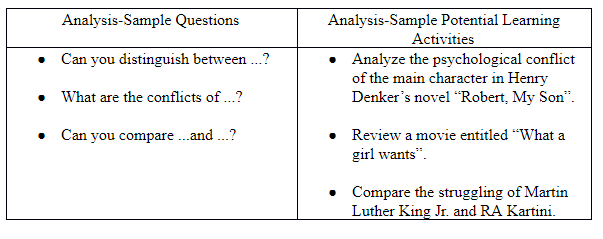
Evaluating (the fifth level of Bloom’s revised taxonomy)
Students are able to make judgements and examine information that they gained, so they can present and defend opinions. Here are some action verbs based on Anderson which can be used for stating the learning objectives; agree, appraise, assess, choose, conclude, criticize, decide, deduct, defend, determine, disprove, evaluate, explain, influence, interpret, judge, justify, mark, measure, perceive, prioritize, prove, recommend, rule on, select, support, value.
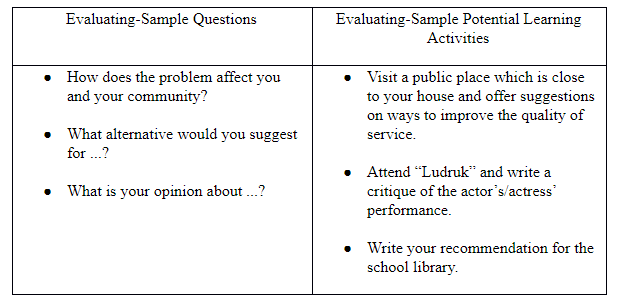
Creating (the top level of Bloom’s revised taxonomy)
Students are able to put the parts or information that they have reviewed together to create/produce something new or propose alternative solutions. Here are some action verbs based on Anderson which can be used for stating the learning objectives; Adapt, Build, Change, Choose, Combine, Compile, Compose, Construct, Create, Design, Develop, Discuss, Elaborate, Estimate, Formulate, Improve, Invent, Make up, Maximize, Minimize, Modify, Originate, Plan, Propose, Solve.
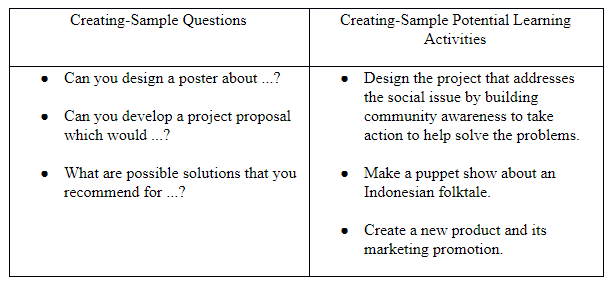
How to enhance HOTs in the classroom?
According to my English teaching experience, using HOTs was challenging. Students were highly motivated to get involved in the learning process. They participated well as they were connected to real situations. In addition, they honed their critical thinking better, and they were more confident in expressing their ideas both orally and written. Based on the learning objectives of some activities, I was able to design the HOTs activities which used various teaching methods and strategies.
Here are samples of HOTs activities in the learning process.
Learning Objectives (Analysis):
Students are able to compare the struggles of Martin Luther King Jr. and RA Kartini.
Topic : Biography Text
Materials : Martin Luther King Jr. biography and RA Kartini biography.
Main activities in the Learning Process
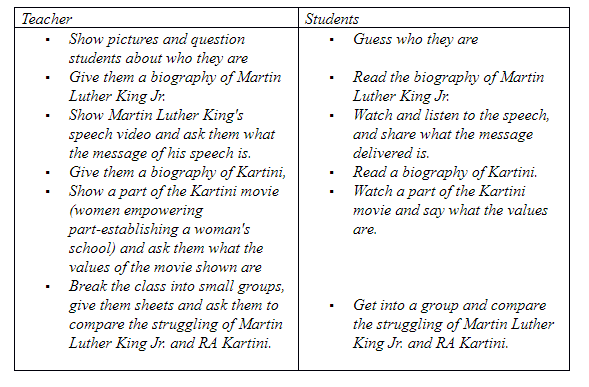
Learning Objectives (Evaluating):
Students are able to write a recommendation for the school library.
Topic : Analytical Exposition text
Materials : School Library
Main activities in Learning Process
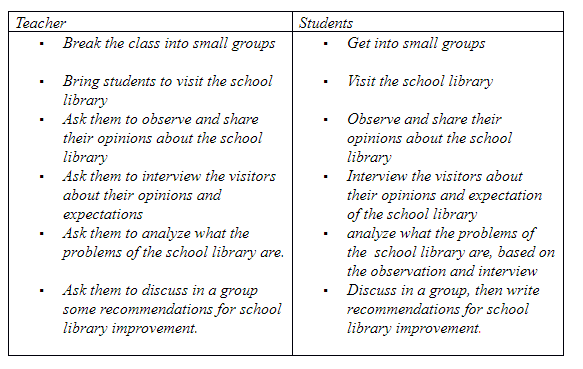
Learning Objectives (Creating):
Students are able to make a puppet show about an Indonesian folktale.
Topic : Narrative text
Materials : Indonesian Folktale
Main activities in Learning Process
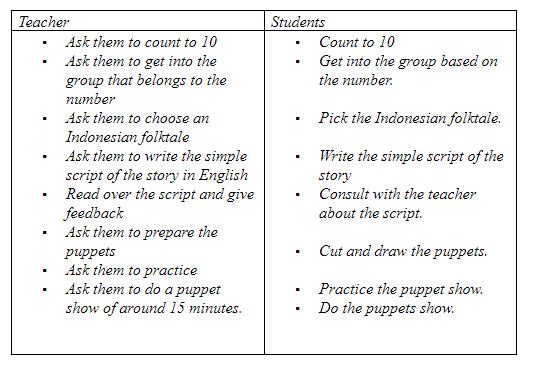
References
- Ali, M.S. (2003). English Language Teaching in Primary Schools: Policy and Implementation concerns. IPBA E-Journal, 1-14.
- Anderson, L. W., & Krathwohl, D. R. (2001). A taxonomy for learning, teaching, and assessing, Abridged Edition. Boston, MA: Allyn and Bacon retrieved from https://www.apu.edu/live_data/files/333/blooms_taxonomy_action_verbs.pdf.
- Anna Rosefsky Saavedran, at all, (2012). TEACHING AND LEARNING 21ST CENTURY SKILLS: Lesson From The Learning Science, RAND Corporation.
- Barahal, S. (2008), Thinking about Thinking: Pre-Service Teachers Strengthen Their Thinking Artfully, Phi Delta Kappan 90 (4).
- Bloom B.S. (1956), Taxonomy of Educational Objectives, Handbook I: The Cognitive Domain, New York: David McKay Co Inc.
- Brookhart, S. (2010), How to Assess Higher Order Thinking Skills in Your Classroom, ASCD.
- Drew Polly, & Leigh Ausband. (2009). Developing Higher-Order Thinking Skills through WebQuest. Volume 26/Number 1Fall 2009 Journal of computing in teacher Education 29
- Robyn Collins. (2014). Skills for the 21st Century: Teaching Higher-order Thinking, Curricullum and Leadership Journal retrieved from http://www.curriculum.edu.au/leader/teaching_higher_order_thinking,37431.html?issueID=12910




